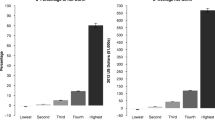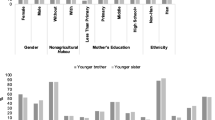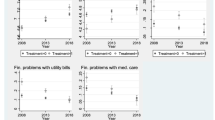Abstract
The objective of this paper is to investigate the direct financial cost and benefit of raising children during a demographic transition in Taiwan, and to examine whether fertility decline is consistent with Caldwell’s wealth flow theory, which states that fertility decline is caused by reduced benefits of children. The paper describes a method of estimating the average economic returns of children over the entire parental lifecycle, using a 42-year span of Taiwanese household and individual economic pseudo-panel data. Results show that returns to children may turn positive and are not highly negative all the time, as found in the previous literature.





Similar content being viewed by others
References
Angeles L (2010) Demographic transitions: analyzing the effects of mortality on fertility. J Popul Econ 23(1):99–120
Athukorala PC, Tsai PL (2003) Determinants of household saving in Taiwan: growth, demography and public policy. J Dev Stud 39(5):65–88
Becker GS (1960) An economic analysis of fertility. In: National Bureau of Economic Research (ed) Demographic and economic change in developed countries. Princeton University Press, Princeton
Bernheim BD, Shleifer A, Summers LH (1985) The strategic bequest motive. J Polit Econ 93(6):1045–1076
Bhaumik SK, Nugent JB (2000) Wealth accumulation, fertility and transfers to elderly heads in Peru. In: Mason A, Tapinos G (eds) Sharing the wealth. Oxford Univeristy Press, New York, pp 256–281
Bhaumik SK, Nugent JB (2010) Real options and demographic decisions: empirical evidence from East and West Germany. Appl Econ. doi:10.1080/00036840903373287.
Björklund A (2006) Does family policy affect fertility? Lessons from Sweden. J Popul Econ 19(1):3–24
Cain GG (1971) Issues in the economics of a population policy for the United States. Am Econ Rev 61(2):408–417
Cain MT (1977) The economic activities of children in a village in Bangladesh. Popul Dev Rev 3(3):201–227
Cain MT (1981) Risk and insurance: Perspectives on fertility and agrarian change in India and Bangladesh. Popul Dev Rev 7(3):435–474
Cain MT (1982) Perspectives on family and fertility in developing countries. Popul Stud 36(2):159–175
Cain MT (1991) Widows, sons, old-age security in rural Maharashtra: a comment on Vlassoff. Popul Stud 45(3):519–528
Cain GG, Weininger A (1973) Economic determinants of fertility. Demography 10(2):205–223
Caldwell JC (1976) Toward a restatement of demographic transition theory. Popul Dev Rev 2(3/4):321–438
Caldwell JC (1978) A theory of fertility: from high plateau to destabilization. Popul Dev Rev 4(4):553–577
Caldwell JC (1980) Theory of fertility decline. Academic, New York
Cleland J, Wilson C (1987) Demand theories of the fertility transition: an iconoclastic view. Popul Stud 41(1):5–30
Cigno A (1992) Children and pension. J Popul Econ 5(3):175–183
Chou SY, Liu JT, Grossman M, Theodore JJ (2007) Parental education and child health: evidence from a natural experiment in Taiwan. National Bureau of Economic Research, NBER Working Paper 13466, Cambridge
DeLancey V (1990) Socioeconomic consequences of high fertility for the family. In: Acsadi GTF, Acsadi GJ, Bulato RA (eds) Population growth and reproduction in Sub Saharan Africa: technical analyses of fertility and its consequences. The World Bank, Washington, DC, pp 115–130
Dharmalingam A (1994) Old age support: expectations and experiences in a south Indian village. Popul Stud 48(1):5–19
Easterlin RA (1978) The economics and sociology of fertility: a synthesis. In: Tilly C (ed) Historical studies of changing fertility. Princeton University Press, Princeton
Easterlin RA, Pollack RA, Wachter ML (1980) Toward a more general economic model of fertility determination: endogenous preferences and natural fertility. In: Easterlin RA (ed) Population and economics change in developing countries. University of Chicago Press, Chicago
Ermisch J (1989) Intergenerational transfers in industrialized countries: effects of age distribution and economic institutions. J Popul Econ 1(4):269–284
Freedman R (1998) Observing Taiwan’s demographic transition: a memoir. Taiwan Provincial Institute of Family Planning, Taichung
Greenhalgh S (1989) Fertility trends in China: approaching the 1990s. Working Paper No 8. The Population Council, New York, pp 1–24
Herbst AF (1990) Handbook of capital investing. Harper Business, New York
Hugo G (1997) Intergenerational wealth flows and the elderly in Indonesia. In: Jones GW, Douglas RM, Caldwell JC, D’Souza RM (eds) The continuing demographic transition. Oxford University Press, New York, pp 111–133
Iyer S, Velu C (2006) Real options and demographic decisions. J Dev Econ 80(1):39–58
Jensen ER (1990) An econometric analysis of the old-age security motive for childbearing. Int Econ Rev 31(4):953–968
Johnson GD (1994) Effects of institutions and policies on rural population growth with application to China. Popul Dev Rev 20(3):503–531
Jones GW (1993) Consequences of rapid fertility decline for old-age security in Asia. In: Leete R, Alam I (eds) The revolution in Asian fertility: dimensions, causes and implications. Clarendon, Oxford, pp 275–295
Kana K, Tsai WD (2003) Parenting practices and children’s education outcomes. IEAS Working Papers, Academic Research 03-A005, Institute of Economics, Academia Sinica, Taipei, Taiwan
Kaplan H (1994) Evolutionary and wealth flows theories of fertility: empirical tests and new models. Popul Dev Rev 20(4):753–791
Kirk D (1996) Demographic transition theory. Popul Stud 50(3):361–387
Kramer K (2005) Maya children: helpers at the farm. Harvard University Press, Cambridge
Lai MS (2006) Three essays in intergeneration transfers: a case study on Taiwan. Dissertation, Department of Economics, University of Hawaii, Honolulu
Lee RD (2000) A Cross-cultural perspective on intergenerational transfers and the economic life cycle. In: A. Mason, & Tapinos, G. (Eds.) Sharing the wealth: demographic change and economic transfers between generations. Oxford University Press, Oxford, pp 17–56
Lee RD (2003) Demographic change, welfare, and intergenerational transfers: a global overview. Genus 59(3–4):3–70
Lee ML (2009) Transition to below replacement fertility and policy response in Taiwan. Jpn J Popul 7(1):71–86
Lee RD, Kramer K (2002) Children’s economic roles in the Maya family life cycle: Cain, Caldwell, and Chayanov revisited. Popul Dev Rev 28(3):475–499
Lee YJ, Parish WL, Willis RJ (1994) Sons, daughters, and intergenerational support in Taiwan. Am J Sociol 99(4):1010–1041
Leibenstein HM (1957) Economic backwardness and economic growth. Wiley, New York
Lesthaeghe R, Surkyn J (1988) Cultural dynamics and economic theories of fertility change. Popul Dev Rev 14(1):1–45
Lin J (1994) Parity and security: a simulation study of old-age support in rural China. Popul Dev Rev 20(2):423–448
Lin CC, Fu VR (1990) A comparison of child-rearing practices among Chinese, immigrant Chinese and Caucasian-American parents. Child Dev 61(2):429–433
Mason A, Ronald L, Tung AC, Lai MS, Miller T (2009) Population aging and intergenerational transfers: introducing age into national income accounts. In: Wise D (ed) Developments in the economics of aging. National Bureau of Economic Research: University of Chicago Press, Chicago, pp 89–122
Mueller E (1976) The economic value of children in peasant society. In: Ridker RG (ed) Population and development: the search for selective interventions. Johns Hopkins University Press, Baltimore, pp 98–153
Nugent JB, Gillaspy RT (1983) Old age pensions and fertility in rural areas of less developed countries: some evidence from Mexico. Econ Dev Cult Change 31(4):809–829
Ogawa N (1993) Health status of the elderly and their labour force participation in the developing countries along the Asia-Pacific Rim. In: Ogawa N, Mauldin GPW, Ross JA (eds) Human resources in development along the Asia-Pacific Rim. Oxford University Press, Oxford
Parish WL, Willis RJ (1993) Daughters, education and family budgets Taiwan experiences. J Hum Resour 28(4):863–898
Ministry of the Interior (2005) Report of Senior Citizen Conditions Survey. Ministry of the Interior, Taipei
Retherford RD, Ogawa N, Sakamoto S (1996) Values and fertility change in Japan. Popul Stud 50(1):5–25
Robinson RS, Lee RD, Kramer K (2008) Counting women’s labor: a reanalysis of children’s net production in Mead Cain’s Bangladeshi village. Popul Stud 62(1):25–38
Rutstein SO (1974) The influence of child mortality on fertility in Taiwan. Stud Fam Plann 5(6):182–188
Schultz TP (1969) An economic model of family planning and fertility. J Polit Econ 77(2):153–180
Schultz TP (1981) Economics of population. Reading, Addison-Wesley
Stecklov G (1999) Evaluating the economic returns to childrearing in Cote d’Ivoire. Popul Stud 53(1):1–17
Taylor C, Jodice D (1983) World handbook of political and social indicators, 3rd edn. Yale University Press, New Haven
Tsai WH (2008) Sociology of aging, 2nd Edn. Wunan, Taipei
Tuan CH (1989) Women in China today. In: Mahadevan K (ed) Woman and population dynamics. Sage, New Delhi, pp 19–63
Tung AC, Lai MS (2010) Living arrangement and elderly support in Taiwan. In: Lee R, Mason A (ed) Population aging and the generational economy. Edward Elgar, London
Tung AC, Chen CC, Liu PKC (2006) The emergence of the neo-extended family in contemporary Taiwan. Ren Kou Xue Kan 32:123–162 (in Chinese)
Vlassoff C (1991) Widows, sons and old-age security in rural Maharastra: rejoinder. Popul Stud 45(3):529–535
Vlassoff M, Vlassoff C (1980) Old age security and the utility of children in rural India. Popul Stud 34(3):487–499
Wilson RW (1970) Learning to be Chinese: the political socialization of children in Taiwan. MIT, Cambridge
Zhang J (1990) Mortality and fertility: how large is the direct child replacement effect in China? J Popul Econ 3(4):303–314
Acknowledgements
The author thanks Andrew Mason, Ronald Lee, An-Chi Tung, Meechai Orsuwan, Sang-Hyop Lee, Robert Retherford, Byron Gangnes, Arnaud Dellis, and two anonymous referees for their valuable comments and suggestions. Research for this paper was supported by National Transfer Accounts project, which was funded by two grants from National Institutes of Health, NIA R01 AG025488 and R37 AG025247.
Author information
Authors and Affiliations
Corresponding author
Additional information
Responsible editor: Junzen Zhang
Electronic Supplementary Material
Below is the link to the electronic supplementary material.
Rights and permissions
About this article
Cite this article
Lai, M.S. When having many children pays: a case study from Taiwan. J Popul Econ 25, 323–348 (2012). https://doi.org/10.1007/s00148-011-0373-9
Received:
Accepted:
Published:
Issue Date:
DOI: https://doi.org/10.1007/s00148-011-0373-9




